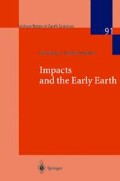Abstract
The 4-km-wide and 0.5-km-deep Kärdla Crater, presently buried under a thin sequence of Upper Ordovician limestone, was formed in a complex target: the crystalline basement was covered by about 170 m of poorly consolidated Lower to Middle Ordovician and Cambrian sediments. The basement-derived granitoids and amphibolites that were subjected to low shock pressure (less than 8 GPa) and are at present either in allochthonous or autochthonous position, have undergone significant impact related chemical and mineralogical alteration. Altered rocks and minerals are fractured and brecciated at different scales. Optical microscopy has shown that plagioclase is altered (“sericitization” or “saussuritization”) and amphibole chloritized. Bulk chemical compositions indicate that sodium and calcium were removed and potassium was brought in. Powder XRD analysis suggests the disappearance of plagioclase and formation of cryptocrystalline orthoclase, in addition to medium- to coarse-grained microcline present in primary rocks. SEM, EDS and EPMA studies reveal that the main secondary minerals are orthoclase, replacing plagioclase in granites and amphibolites, and chlorite, replacing hornblende in amphibolites. The extent of chemical and mineralogical alteration is closely related to microfractures. However, alteration has selectively changed the minerals. Plagioclase, hornblende and biotite have changed dramatically, whereas zircon, quartz and also primary microcline remained almost unaffected. Geological and mineralogical data suggest that this alteration was related to fireball — target rock interaction during the impact process.
Preview
Unable to display preview. Download preview PDF.
References
Brown WL, Parsons I (1994) Feldspars in igneous rocks. In: Parsons I (ed.) Feldspars and their reactions. Kluwer. Dordecht-Boston-London, pp 449–499
French BM, Koeberl C, Gilmour I, Shirey SB, Dons JA, Naterstad J (1997) The Gardnos impact structure, Norway: Petrology and geochemistry of target rocks and impactites. Geochim Cosmochim Acta 61: 873–904
Huffman AR, Reimold WU (1996) Experimental constraints on shock-induced microstructures in naturally deformed silicates. Tectonophysics 256: 165–217
Jõeleht A (1995) Petrophysical properties of Estonian bedrock. Report, Department of Marine Geology and Geophysics, Geological Survey of Estonia, Tallinn, 32 pp (In Estonian)
Kivisilla J, Niin M, Koppelmaa H (1999) Catalogue of chemical analyses of major elements in the rocks of the crystalline basement of Estonia. Geological Survey of Estonia, Tallinn, 97 pp
Koeberl C (1997) Impact cratering: the mineralogical and geochemical evidence. Oklahoma Geological Survey Circular 100: 30–54
Koeberl C, Reimold WU, Kracher A, Träxler B, Vormaier A, Körner W (1996) Mineralogical and petrological, and geochemical studies of drill cores from the Manson impact structure, Iowa. In: Koeberl C, Anderson RR (eds.) The Manson Impact Structure, Iowa: Anatomy of an Impact Crater. Geological Society of America Special Paper 302: 145–219
Konsa M, Puura V (1999) Provenance of zircon of the lowermost sedimentary cover, Estonia, East-European Craton. Bulletin of the Geological Society of Finland 71 (In press)
Koppelmaa H, Niin M, Kivisilla J (1996) About the petrography of the crystalline basement rocks in the Kärdla crater area, Hiiumaa Island, Estonia. Bulletin of the Geological Survey of Estonia 6: 4–24
Kroll H, Ribbe PH (1987) Determining (Al, Si) distribution and strain in alkali feldspars using lattice parameters and diffraction peak positions: A review. American Mineralogist 72: 491–506
Plado J, Pesonen LJ, Elo S, Puura V, Suuroja K (1996) Geophysical research on the Kärdla impact structure, Hiiumaa Island, Estonia. Meteoritics Planet Sci 31: 289–298
Puranen R, Sulkanen K (1995) Technical description of microcomputer-controlled petrophysical laboratory. Open File Report Q15/27/85/1, Department of Geophysics, Geological Survey of Finland, Espoo, 252 pp
Puura V, Huhma H (1993) Palaeoproterozoic age of the East Baltic granulitic crust. Precambrian Research 64: 289–294
Puura V, Kirsimäe K, Kivisilla J, Plado J, Puura I, Suuroja K (1996) Geochemical anomalies of terrestrial compounds in nonmelted impactites at Kärdla, Estonia. Meteoritics Planet Sci 31: A112–A113
Puura V, Sudov B (1976) On the platform tectonic activation zones in the southern slope of the Baltic shield, and their metallogeny. Proceedings of the Academy of Sciences of Estonian SSR. Geology 25: 206–214
Puura V, Suuroja K (1992) Ordovician impact crater at Kärdla, Hiiumaa Island, Estonia. Tectonophysics 216: 143–156
Puura V, Vaher R, Klein V, Koppelmaa H, Niin M, Vanamb V, Kirs J (1983) The Crystalline Basement of Estonian Territory. Nauka, Moscow, 207 pp (In Russian)
Reimold WU, Koeberl C, Bishop J (1994) Roter Kamm impact crater, Namibia: Geochemistry of basement rocks and breccias. Geochim Cosmochim Acta 58: 2689–2710
Suuroja S (1999) Lithologies of within-crater breccias of the Kärdla crater. MSc Thesis, Institute of Geology, University of Tartu, 78 pp (In Estonian)
Wright TL (1968) X-ray and optical study of alkali feldspar: II. An X-ray method for determinig the composition and structural state from measurement of 20 values for three reflections. American Mineralogist 53: 88–104
Yakovlev OI, Parfenova OB (1982) Petrochemical characteristics of impactites, and consequences of vaporization and condensation in course of meteorite cratering. Meteoritika 40: 113–121 (In Russian)
Author information
Authors and Affiliations
Editor information
Rights and permissions
Copyright information
© 2000 Springer-Verlag
About this chapter
Cite this chapter
Puura, V. et al. (2000). Impact-induced replacement of plagioclase by K-feldspar in granitoids and amphibolites at the Kärdla Crater, Estonia. In: Gilmour, I., Koeberl, C. (eds) Impacts and the Early Earth. Lecture Notes in Earth Sciences, vol 91. Springer, Berlin, Heidelberg. https://doi.org/10.1007/BFb0027770
Download citation
DOI: https://doi.org/10.1007/BFb0027770
Published:
Publisher Name: Springer, Berlin, Heidelberg
Print ISBN: 978-3-540-67092-6
Online ISBN: 978-3-540-46578-2
eBook Packages: Springer Book Archive

